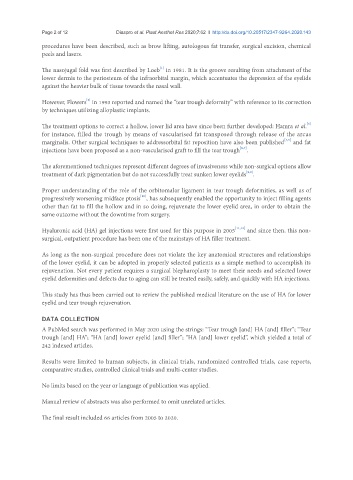Page 726 - Read Online
P. 726
Page 2 of 12 Diaspro et al. Plast Aesthet Res 2020;7:62 I http://dx.doi.org/10.20517/2347-9264.2020.143
procedures have been described, such as brow lifting, autologous fat transfer, surgical excision, chemical
peels and lasers.
[1]
The nasojugal fold was first described by Loeb in 1981. It is the groove resulting from attachment of the
lower dermis to the periosteum of the infraorbital margin, which accentuates the depression of the eyelids
against the heavier bulk of tissue towards the nasal wall.
[2]
However, Flowers in 1993 reported and named the “tear trough deformity” with reference to its correction
by techniques utilizing alloplastic implants.
[3]
The treatment options to correct a hollow, lower lid area have since been further developed: Hamra et al.
for instance, filled the trough by means of vascularised fat transposed through release of the arcus
[4,5]
marginalis. Other surgical techniques to addressorbital fat reposition have also been published and fat
injections have been proposed as a non-vascularised graft to fill the tear trough .
[6,7]
The aforementioned techniques represent different degrees of invasiveness while non-surgical options allow
[8,9]
treatment of dark pigmentation but do not successfully treat sunken lower eyelids .
Proper understanding of the role of the orbitomalar ligament in tear trough deformities, as well as of
[10]
progressively worsening midface ptosis , has subsequently enabled the opportunity to inject filling agents
other than fat to fill the hollow and in so doing, rejuvenate the lower eyelid area, in order to obtain the
same outcome without the downtime from surgery.
Hyaluronic acid (HA) gel injections were first used for this purpose in 2005 [11,12] and since then, this non-
surgical, outpatient procedure has been one of the mainstays of HA filler treatment.
As long as the non-surgical procedure does not violate the key anatomical structures and relationships
of the lower eyelid, it can be adopted in properly selected patients as a simple method to accomplish its
rejuvenation. Not every patient requires a surgical blepharoplasty to meet their needs and selected lower
eyelid deformities and defects due to aging can still be treated easily, safely, and quickly with HA injections.
This study has thus been carried out to review the published medical literature on the use of HA for lower
eyelid and tear trough rejuvenation.
DATA COLLECTION
A PubMed search was performed in May 2020 using the strings: “Tear trough [and] HA [and] filler”; “Tear
trough [and] HA”; “HA [and] lower eyelid [and] filler”; “HA [and] lower eyelid”, which yielded a total of
242 indexed articles.
Results were limited to human subjects, in clinical trials, randomized controlled trials, case reports,
comparative studies, controlled clinical trials and multi-center studies.
No limits based on the year or language of publication was applied.
Manual review of abstracts was also performed to omit unrelated articles.
The final result included 66 articles from 2005 to 2020.

